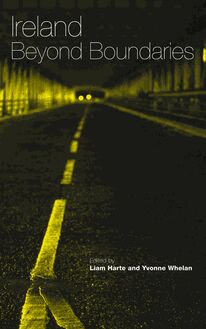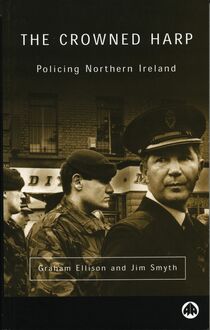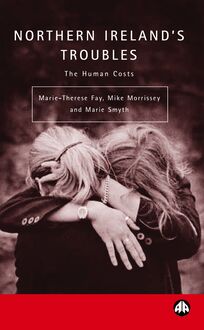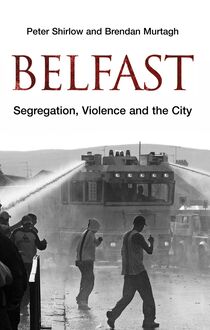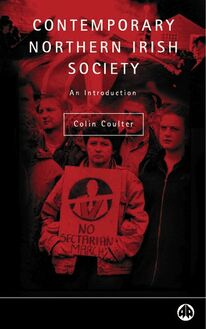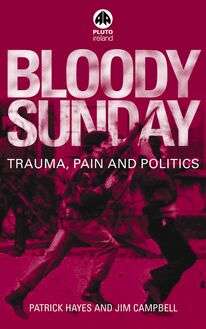-
 Univers
Univers
-
 Ebooks
Ebooks
-
 Livres audio
Livres audio
-
 Presse
Presse
-
 Podcasts
Podcasts
-
 BD
BD
-
 Documents
Documents
-
- Cours
- Révisions
- Ressources pédagogiques
- Sciences de l’éducation
- Manuels scolaires
- Langues
- Travaux de classe
- Annales de BEP
- Etudes supérieures
- Maternelle et primaire
- Fiches de lecture
- Orientation scolaire
- Méthodologie
- Corrigés de devoir
- Annales d’examens et concours
- Annales du bac
- Annales du brevet
- Rapports de stage
La lecture à portée de main
236 pages
English
Découvre YouScribe en t'inscrivant gratuitement
Je m'inscrisDécouvre YouScribe en t'inscrivant gratuitement
Je m'inscris
Obtenez un accès à la bibliothèque pour le consulter en ligne
En savoir plus
En savoir plus
236 pages
English
Obtenez un accès à la bibliothèque pour le consulter en ligne
En savoir plus
En savoir plus

Description
Over the last decade the Irish economy has experienced a period of unprecedented growth which has earned it the title Celtic Tiger. This success has been interpreted by academic commentators as marking a social and cultural transformation, what some have called the reinvention of Ireland. The essays in this book challenge the largely positive interpretation of Ireland's changing social order.
The authors identify the ways in which culture and society have been made subservient to the needs of the market in this new neoliberal Ireland. They draw on subversive strands in Irish history and offer a broader and more robust understanding of culture as a site of resistance to the dominant social order and as a political means to fashion an alternative future.
Contributors
1. The Reinvention of Ireland: A Critical Perspective by Peadar Kirby, Luke Gibbons and Michael Cronin
Section I: Economy and Society
2. Contested Pedigrees of the Celtic Tiger by Peadar Kirby
3. Culture and State in Ireland’s New Economy by Michel Peillon
4. Speed Limits: Ireland, Globalisation and the War against Time by Michael Cronin
Section II: Public Spaces
5. Citizenship and Education: A Crisis of the Republic? by Joseph Dunne
6. The Global Cure? History, Therapy and the Celtic Tiger by Luke Gibbons
Section III: Historical Legacies
7. Colonialism and the Celtic Tiger: Legacies of History and the Quest for Vision by Geraldine Moane
8: Religion and the Celtic Tiger: The Cultural Legacies of Anti-Catholicism in Ireland by Lionel Pilkington
Section IV: Media
9. The Celtic Tiger’s Media Pundits by Barra Ó Séaghdha
10. Broadcasting and the Celtic Tiger: From Promise to Practice by Roddy Flynn
11. Screening the Green: Cinema under the Celtic Tiger by Debbie Ging
12. Conclusions and Transformations by Peadar Kirby, Luke Gibbons and Michael Cronin
Bibliography
Index
The authors identify the ways in which culture and society have been made subservient to the needs of the market in this new neoliberal Ireland. They draw on subversive strands in Irish history and offer a broader and more robust understanding of culture as a site of resistance to the dominant social order and as a political means to fashion an alternative future.
Contributors
1. The Reinvention of Ireland: A Critical Perspective by Peadar Kirby, Luke Gibbons and Michael Cronin
Section I: Economy and Society
2. Contested Pedigrees of the Celtic Tiger by Peadar Kirby
3. Culture and State in Ireland’s New Economy by Michel Peillon
4. Speed Limits: Ireland, Globalisation and the War against Time by Michael Cronin
Section II: Public Spaces
5. Citizenship and Education: A Crisis of the Republic? by Joseph Dunne
6. The Global Cure? History, Therapy and the Celtic Tiger by Luke Gibbons
Section III: Historical Legacies
7. Colonialism and the Celtic Tiger: Legacies of History and the Quest for Vision by Geraldine Moane
8: Religion and the Celtic Tiger: The Cultural Legacies of Anti-Catholicism in Ireland by Lionel Pilkington
Section IV: Media
9. The Celtic Tiger’s Media Pundits by Barra Ó Séaghdha
10. Broadcasting and the Celtic Tiger: From Promise to Practice by Roddy Flynn
11. Screening the Green: Cinema under the Celtic Tiger by Debbie Ging
12. Conclusions and Transformations by Peadar Kirby, Luke Gibbons and Michael Cronin
Bibliography
Index
Sujets
Informations
| Publié par | Pluto Press |
| Date de parution | 20 avril 2002 |
| Nombre de lectures | 0 |
| EAN13 | 9781849641272 |
| Langue | English |
| Poids de l'ouvrage | 1 Mo |
Informations légales : prix de location à la page 0,6250€. Cette information est donnée uniquement à titre indicatif conformément à la législation en vigueur.
Extrait
REINVENTING IRELAND Culture, Society and the Global Economy
Edited by Peadar Kirby, Luke Gibbons and Michael Cronin
P Pluto Press LONDON • STERLING, VIRGINIA
First published 2002 by Pluto Press 345 Archway Road, London N6 5AA and 22883 Quicksilver Drive, Sterling, VA 20166–2012, USA
www.plutobooks.com
Copyright © Peadar Kirby, Luke Gibbons and Michael Cronin 2002
The right of the individual contributors to be identified as the authors of this work has been asserted by them in accordance with the Copyright, Designs and Patents Act 1988.
British Library Cataloguing in Publication Data A catalogue record for this book is available from the British Library
ISBN 0 7453 1825 8 hardback ISBN 0 7453 1824 X paperback
Library of Congress Cataloging in Publication Data Reinventing Ireland : culture, society, and the global economy / edited by Peadar Kirby, Luke Gibbons and Michael Cronin. p. cm. –– (Contemporary Irish studies) ISBN 0–7453–1825–8 (hardback) –– ISBN 0–7453–1824–X (pbk.) 1. Ireland––Economic conditions––1949– 2. Ireland––Social conditions. I. Kirby, Peadar. II. Gibbons, Luke. III. Cronin, Michael, 1960– IV. Series. HC260.5 .R44 2002 306'.09417––dc21 200100811
Reprints:
10
9
8
7
6
5
4
3
2
1
0
5
Designed and produced for Pluto Press by Chase Publishing Services, Fortescue, Sidmouth EX10 9QG Typeset by Stanford DTP Services, Towcester Printed in the European Union by Antony Rowe, Chippenham, England
Contents
1 Introduction: The Reinvention of Ireland: A Critical Perspective Peadar Kirby, Luke Gibbons and Michael Cronin
PART I: ECONOMY AND SOCIETY
2 Contested Pedigrees of the Celtic Tiger Peadar Kirby 3 Culture and State in Ireland’s New Economy Michel Peillon 4 Speed Limits: Ireland, Globalisation and the War against Time Michael Cronin
PART II: PUBLIC SPACES
5 Citizenship and Education: A Crisis of the Republic? Joseph Dunne 6 The Global Cure? History, Therapy and the Celtic Tiger Luke Gibbons
PART III: HISTORICAL LEGACIES
7 Colonialism and the Celtic Tiger: Legacies of History and the Quest for Vision Geraldine Moane 8 Religion and the Celtic Tiger: The Cultural Legacies of Anti-Catholicism in Ireland Lionel Pilkington
PART IV: MEDIA
9 The Celtic Tiger’s Media Pundits Barra Ó Séaghdha
1
21
38
54
69
89
109
124
143
vi
REINVENTING IRELAND
10 Broadcasting and the Celtic Tiger: From Promise to Practice Roddy Flynn 11 Screening the Green: Cinema under the Celtic Tiger Debbie Ging 12 Conclusions and Transformations Peadar Kirby, Luke Gibbons and Michael Cronin
Bibliography Contributors Index
160
177
196
209 222 224
1
Introduction: The Reinvention of Ireland: A Critical Perspective
Peadar Kirby, Luke Gibbons and Michael Cronin
Culture is not some vague fantasy of fulfilment, but a set of potentials bred by history and subversively at work within it. Terry Eagleton:,The Idea of Culture(2000: 23)
‘Ireland reinvented itself during the 1990s’, boldly proclaimed the 1999 strategy document of the National Economic and Social Council (NESC), a three-year outline of economic and social policy agreed by all the social partners (government, business, farmers’ groups, trade unions and the community and voluntary sector) (NESC 1999: 21). Though the NESC makes no reference to the source of the concept, the notion of Ireland reinventing itself is drawn from the work of Professor Rory O’Donnell, whose extensive writings on Ireland’s social partnership have invested the concept with major international significance as an innovative model of economic and social governance (see O’Donnell 1999, 2000a; O’Donnell and Thomas 1998). This led O’Donnell to turn his attention to culture. Lamenting what he described as the excessive and unhappy dualism between the economic and the cultural, the material and the moral in contempor-ary Ireland, he defined a new project ‘to reunite our account of the cultural and the economic, the normative and the material, the actual and the ideal’ (1999: 34). In offering a cultural reading of Ireland’s immediate past, he drew on Kiberd’s notion that modern Ireland was invented in the cultural revival of the late nineteenth and early twentieth centuries (Kiberd 1995). O’Donnell co-wrote in 1998 that ‘Ireland and the Irish people continue the journey of re-invention at the close of the twentieth century’ (Laffan and O’Donnell 1998: 175). In April 1999 he specified further in claiming that ‘changes in the public sphere’ such as European integration and social partnership can be seen as part of the reinvention of Ireland, a new culture closely related to the successful economy (O’Donnell 1999: 32–3). This ‘new culture’ is the subject of this book. The contributors map its contours in different areas of Irish life and from different dis-
1
2
REINVENTING IRELAND
ciplinary perspectives. While the authors adopt their own stances towards this new culture – stances not always in agreement with one another – what unites them is their critical engagement with their subjects, placing these in an historical context and tracing the forces that have given them their current shape and form, an approach to Ireland’s ‘new culture’ which contrasts with that of its dominant proponents. This is characterised by an adulatory and uncritical tone, and which often fails to trace the new culture’s historical develop-ment or to identify the forces which have shaped it. Instead, it is seen as marking a break with the past and the coming-of-age of an enlight-ened, tolerant and liberal Ireland. Furthermore, while this ‘new culture’ is closely linked by its proponents with Ireland’s economic 1 success of the 1990s, widely referred to as ‘the Celtic Tiger’, the links between economy and culture have been little explored apart from a generalised correlation between economic success and a climate of national self-confidence and creativity. The authors in this bookexplore the links more closely, illustrating ways in which the precondition of Ireland’s economic success, namely subservient inte-gration into a radical free-market or Anglo-American informational 2 capitalism, has itself shaped values, attitudes and forms of cultural expression which function within the contemporary Irish economy. In this manner, then, the bookuncovers more fully and analytically the nature and content of this ‘reinvented’ Ireland and the way in which culture has become the handmaiden of a particular type of economy. Furthermore, some of the authors in these pages go beyond mapping this new culture and illustrating its economic func-tionality. They explore ways in which culture could inspire political resistance and alternatives, using an engagement with Ireland’s past to identify resources for reimagining and reinventing a different Ireland of the future. Part I, Economy and Society, contains three chapters which examine in different ways the relationship between culture, economy and society under the Celtic Tiger. In Chapter 2 Peadar Kirby examines the nature of the ‘reinvented Ireland’ of the 1990s, con-trasting the bases for this reinvention with those which resulted in the original invention of Ireland over a century ago. In Chapter 3 Michel Peillon argues that the connection between economy and culture has been fundamentally altered in the Ireland of the Celtic Tiger, since culture as social critique has given way to culture as economic commodity, both as a factor of production and a means of consump-tion. Michael Cronin explores in Chapter 4 what he calls ‘the chrono-politicisation of Ireland’, the effects of the new time-zones that are shaping Irish culture and society. He finds that ‘in consumer societies where mobility has become a supreme virtue, the immobile are the losers’.
INTRODUCTION: A CRITICAL PERSPECTIVE
3
The Public Sphere is the theme of Part II. In Chapter 5 Joe Dunne addresses the weakening basis of citizenship as we become more implicated in a consumerist culture and resigned to the inexorable logic of economic growth. He argues for a notion of citizenship anchored in a robust practice of solidarity. In Chapter 6 Luke Gibbons explores the basis for a more multicultural public sphere in Ireland. He questions the assumption that welcoming other cultural influences requires an act of amnesia, or a disavowal of the heteroge-neous and often conflicting elements within one’s own culture. Part III examines a number of historical legacies and how they influence Irish society today. In Chapter 7 Ger Moane looks at the psychological legacy of colonialism and identifies ways in which it still manifests itself through various cultural pathologies such as high levels of alcohol and drug consumption, patterns of denial and doublethink, distortions of sexuality and social irresponsibility. In Chapter 8 Lionel Pilkington discusses the relationship between Irish modernity and religious and denominational identity, and surveys some of the historical and political reasons for the assumption that Catholicism is considered to be an impediment to Irish modernisation. Part IV, Media, contains three chapters which deal with different media through which Celtic Tiger Ireland portrays itself to the world. In Chapter 9 Barra Ó Séaghdha analyses critically the world view of some prominent Irish commentators who have interpreted contem-porary Ireland to the outside world. He devotes most attention to the work of journalist Fintan O’Toole, identifying the themes of his work and the limits of his intellectual horizons. The neo-liberalisation of Irish broadcasting is the subject of Chapter 10. Roddy Flynn argues that, far from offering more diversity on the airwaves, the advent of commercial broadcasting has narrowed the range of material available to Irish audiences as commercial criteria assume ever greater dominance. In Chapter 11 Debbie Ging compares the representation of Ireland in the films of the late 1990s and early 2000s with the gritty social realism of the First Wave of Irish film-making from the 1970s and 1980s. She finds that a booming economy has begun to erase self-questioning in favour of a more marketable version of Irishness. In the final chapter the editors discuss the main conclusions to be drawn from the contributions to the book, and explore ways in which culture offers the basis for forms of political practice which hold the promise of a more radical, egalitarian and multicultural society in Ireland. Apart from this brief outline of the book’s distinctive approach and its contents, this introductory chapter undertakes three tasks. The first examines the dominant understandings of Ireland’s economic and cultural success in the 1990s, identifying features of the orthodoxy which are functional to the existence and maintenance of the present
4
REINVENTING IRELAND
social order. These orthodoxies are briefly mapped out and reference made to ways in which they are examined in various of the book’s chapters. The second task interrogates the understanding of culture that informs these orthodoxies and contrasts this with understandings which were dominant in previous eras of Irish life. It goes on to flesh out a fuller understanding of culture as the site of struggle over which social meaning achieves hegemony or dominance and illustrates ways in which these struggles are taking place in contemporary Ireland. The final task looks to the future and the role that culture plays in political stances in facing up to the dominant order. It argues that the attitude that culture is simply there to serve the needs of the economy consti-tutes one of the principal reasons for the failure to construct and articulate more effective, broad-ranging challenges to the dominant social order. The chapter concludes with an argument for an innovative appropriation of culture as a means of developing a new critical political space within contemporary Irish society.
The Celtic Tiger and its Orthodoxy
In the social science literature on the Celtic Tiger, three principal approaches can be identified. Each draws on different theoretical frameworks and, as a result, focuses on distinctive aspects of the phenomenon. The first, drawing on neo-classical economics and on new growth theory, focuses almost exclusively on economic success and the conditions underlying it. In this account, high productivity, cost competitiveness, wage restraint and curbs on public spending are identified as the main contributors to economic success (see, for example, Barry 1999; Leddin and Walsh 1997; Bradley 2000; Fitzgerald 2000). The high levels of economic growth which have resulted are seen as marking a permanent transformation of the Irish economy, holding out the prospect that ‘Ireland may achieve a standard of living among the highest within the EU’ over the next 15 years (Fitzgerald, 2000: 54). This literature largely neglects the social impact of economic growth, seeing economic growth as an end in itself. It rests on the benign individualist and utilitarian assumptions which inform neo-classical economics and which assume that economic growth results in positive social outcomes (see Kirby 2002, Chapter 4, for a fuller discussion). It is highly influential in economic policy-making and can be regarded as the dominant, hegemonic inter-pretation of the Celtic Tiger. A second reading, consistent with the dominant economistic reading but adopting a distinctive focus of its own and drawing on very different theoretical understandings, can be identified in the political economy approaches of O’Donnell (2000b) and Ó Riain
INTRODUCTION: A CRITICAL PERSPECTIVE
5
(1997a, 1997b, 2000; Ó Riain and O’Connell 2000). These take the institutions of the Irish state as their focus of analysis, arguing that the success of the Celtic Tiger is largely the result of what O’Donnell calls ‘the emerging Irish model of economic and social governance’ (in Laffan and O’Donnell 1998: 165). O’Donnell attributes to the 3 institutions of social partnership a central role in mediating Ireland’s transformation from economic laggard to economic star through aligning state strategy with economic and social interests (see O’Donnell 2000b). Drawing on the international literature on the developmental state, Ó Riain likens the Irish state’s ability to foster more successful connections with global economic forces to the legendary success of the East Asian states of Japan, South Korea and Taiwan in the post-war period. In this reading, then, it is the state rather than the market which plays the crucial role in mediating success. Furthermore, the importance attached by both these theorists to social partnership points up the fact that they devote attention to the mechanisms whereby economic success is translated into social success, though O’Donnell offers a far more optimistic assessment of this than does Ó Riain. Both, however, agree that Ireland has been transformed economically through the agency of the state; it is a reading which exercises some influence, especially among state elites, and may underpin the apparent determination of the state to maintain and further develop the institutions of social partnership. The final reading draws on more critical currents within social theory, particularly on Marxism, world-systems theory and the new international political economy. Allen’s account (1999, 2000) offers a conventional Marxist analysis emphasising how the Celtic Tiger economy has enriched a small elite while leaving the majority, the growth in whose wages has been held in check by national social part-nership agreements, relatively worse off. O’Hearn uses world-systems theory to argue that Ireland has ‘bought economic tigerhood’ (2000: 74) on the basis of its reliance on multinational capital. By contrast, the East Asian tigers succeeded in developing strong indigenous industrial sectors and winning export markets for their products. He links growing social inequality to the nature of the Irish growth model, arguing that employment is concentrated in low-paid service jobs and that the Irish state’s fiscal policies favour the rich (1998). A final con-tributor to this literature is Kirby (2000, 2002). He argues that, under the Celtic Tiger, economic success correlates with social failure and uses a theoretical approach which draws on international political economy to show how the actions of the state have favoured market forces to the detriment of social well-being. What these analysts have in common is concern about the inequitable social impact of economic growth. While this approach has little influence among
6
REINVENTING IRELAND
economic or state elites, it exercises more influence among activist sectors of civil society. Debates on contemporary Ireland are furthermore informed by a powerful orthodoxy relating to a shared understanding of the Irish past. The three components of this understanding might be described as having their origins in an economic, historical and aesthetic pre-sentation of previous Irish experience. In the economic sphere the dominant narrative is one sketched out by Conor McCarthy when he describes the genesis of modernisation in the Irish Republic:
Up to this time [the late 1950s], a chauvinistic economic national-ism had been pursued, that found its ideological basis in post-Independence isolationism, wartime neutrality and the ambivalence of the political and economic relationship with Britain. This issued in policies based on the development of the agricultural sector, import substitution and protectionism that had been pursued since the Second World War. These policies had now been revealed to be wholly inadequate to the country’s needs. (McCarthy 2000: 12–13)
T.K. Whitaker’s 1958 White Paper onEconomic Developmentis the decisive policy move, backed by Lemass, that marks a break with the previous economic policies of post-independence Ireland and is signalled as the prelude to growth in the 1960s (Brown 1985). The power of this founding narrative for the architects of Irish mod-ernisation can be seen in the fact that almost 40 years later it is still a virtually unquestioned tenet of political faith that the economic mod-ernisation of the 1960s was a wholly good thing. A second constitutive element of orthodox understandings of the past was the decisive change in perspectives on Irish historiography initiated in the mid-1960s. The main thrust of the writings of O’Brien, Lyons, Foster, McDonagh and others was to challenge the nationalist meta-narratives whether in representations of key historical events (the Famine, 1916 Rising, the Hidden Ireland of the eighteenth century), important historical figures (PatrickPearse, Oliver Cromwell) or the degree of Irish antipathy to Empire (O’Brien 1972; Lyons 1973; Lyons 1979; MacDonagh 1983; Foster 1989; Wilson Foster 1991; Brady 1994). The shift in historical sympathies was not only inevitable with the arrival of a younger group of scholars on the Irish university scene but also complemented the aggressive commitment of the state to inte-gration into the international neo-liberal system and a desire on the part of the new elites to repudiate a now discredited and devalued nationalist reading of history (Mac Laughlin 1994). The deep hostility to nationalist readings of Irish history was of course also determined by the military conflict in Northern Ireland and the desire of both the
-
 Univers
Univers
-
 Ebooks
Ebooks
-
 Livres audio
Livres audio
-
 Presse
Presse
-
 Podcasts
Podcasts
-
 BD
BD
-
 Documents
Documents
-
Jeunesse
-
Littérature
-
Ressources professionnelles
-
Santé et bien-être
-
Savoirs
-
Education
-
Loisirs et hobbies
-
Art, musique et cinéma
-
Actualité et débat de société
-
Jeunesse
-
Littérature
-
Ressources professionnelles
-
Santé et bien-être
-
Savoirs
-
Education
-
Loisirs et hobbies
-
Art, musique et cinéma
-
Actualité et débat de société
-
Actualités
-
Lifestyle
-
Presse jeunesse
-
Presse professionnelle
-
Pratique
-
Presse sportive
-
Presse internationale
-
Culture & Médias
-
Action et Aventures
-
Science-fiction et Fantasy
-
Société
-
Jeunesse
-
Littérature
-
Ressources professionnelles
-
Santé et bien-être
-
Savoirs
-
Education
-
Loisirs et hobbies
-
Art, musique et cinéma
-
Actualité et débat de société
- Cours
- Révisions
- Ressources pédagogiques
- Sciences de l’éducation
- Manuels scolaires
- Langues
- Travaux de classe
- Annales de BEP
- Etudes supérieures
- Maternelle et primaire
- Fiches de lecture
- Orientation scolaire
- Méthodologie
- Corrigés de devoir
- Annales d’examens et concours
- Annales du bac
- Annales du brevet
- Rapports de stage
Signaler un problème
YouScribe
Le catalogue
Le service
© 2010-2024 YouScribe

